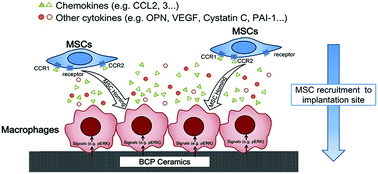当前位置:
X-MOL 学术
›
J. Mater. Chem. B
›
论文详情
Our official English website, www.x-mol.net, welcomes your feedback! (Note: you will need to create a separate account there.)
Calcium phosphate altered the cytokine secretion of macrophages and influenced the homing of mesenchymal stem cells†
Journal of Materials Chemistry B ( IF 7 ) Pub Date : 2018-06-14 00:00:00 , DOI: 10.1039/c8tb01201f Menglu Wang 1, 2, 3, 4 , Fuying Chen 1, 2, 3, 4 , Jing Wang 1, 2, 3, 4 , Xuening Chen 1, 2, 3, 4 , Jie Liang 1, 2, 3, 4 , Xiao Yang 1, 2, 3, 4 , Xiangdong Zhu 1, 2, 3, 4 , Yujiang Fan 1, 2, 3, 4 , Xingdong Zhang 1, 2, 3, 4
Journal of Materials Chemistry B ( IF 7 ) Pub Date : 2018-06-14 00:00:00 , DOI: 10.1039/c8tb01201f Menglu Wang 1, 2, 3, 4 , Fuying Chen 1, 2, 3, 4 , Jing Wang 1, 2, 3, 4 , Xuening Chen 1, 2, 3, 4 , Jie Liang 1, 2, 3, 4 , Xiao Yang 1, 2, 3, 4 , Xiangdong Zhu 1, 2, 3, 4 , Yujiang Fan 1, 2, 3, 4 , Xingdong Zhang 1, 2, 3, 4
Affiliation

|
Immune cells such as macrophages play an important role in tissue regeneration. In this study, an in vivo mouse intramuscular implantation model was applied to demonstrate the gradual infiltration of macrophages, followed by homing of mesenchymal stem cells (MSCs) during the early phase of biphasic calcium phosphate (BCP)-induced ectopic bone formation. Then, a novel real-time cell analysis (RTCA) system was used to continuously monitor cell migration in vitro, suggesting the positive roles of BCP-mediated macrophage secretion in MSC recruitment. A Proteome Profiler cytokine array was also applied to investigate the BCP-stimulated secretion pattern of macrophages by simultaneously screening 111 cytokines, indicating that Raw 264.7 macrophages released a pronounced amount of chemokines (CCL2, 3, 4, 5 and CXCL2, 10, 16) and non-chemokine molecules (OPN, VEGF, CD14, Cystatin C and PAI-1), which are involved in cell homing and bone regeneration. Among them, osteoinductive BCP ceramics significantly promoted the secretion of CCL2, 3, 4 and Cystatin C in macrophages, which was consistent with the up-regulated expression of chemokine genes (Ccl2, 3, 4). Considering their previously-reported chemotactic functions, the effects of CCL2/MCP-1 and CCL3/MIP-1α on MSC recruitment were further evaluated by the RTCA system. It was found that exogenous CCL2/MCP-1 and CCL3/MIP-1α dramatically accelerated MSC migration, while their neutralizing antibodies reduced MSC motility. Moreover, BCP-mediated macrophage secretion up-regulated the gene expression of chemokine receptors (Ccr1 and Ccr2) in MSCs, but the blockage of CCR1 and CCR2 exerted inhibitory effects on MSC chemotaxis. RTCA results showed that compared to CCL3/CCR1, the CCL2/CCR2 axis might exert a predominant chemotactic effect for MSC recruitment. These findings indicated that osteoinductive BCP ceramics might regulate macrophage secretion via an ERK signaling pathway, and the increased release of chemokines in macrophages would accelerate MSC homing to facilitate bone formation. These findings might deepen our understanding of biomaterial-mediated immune response and help to design orthopedic implants with desired immunomodulatory abilities to recruit host stem cells endogenously for bone regeneration.
中文翻译:

磷酸钙改变巨噬细胞的细胞因子分泌并影响间充质干细胞的归巢†
免疫细胞(例如巨噬细胞)在组织再生中起重要作用。在这项研究中,采用了体内小鼠肌肉内植入模型来证明巨噬细胞逐渐浸润,然后在双相磷酸钙(BCP)诱导的异位骨形成的早期归巢间充质干细胞(MSC)。然后,使用新型实时细胞分析(RTCA)系统连续监测体外细胞迁移,提示BCP介导的巨噬细胞分泌在MSC募集中的积极作用。通过同时筛选111种细胞因子,Proteome Profiler细胞因子阵列也被用于研究BCP刺激的巨噬细胞分泌模式,表明Raw 264.7巨噬细胞释放了大量的趋化因子(CCL2、3、4、5和CXCL2、10、16)。以及非趋化因子分子(OPN,VEGF,CD14,胱抑素C和PAI-1),它们参与细胞归巢和骨骼再生。其中,骨诱导BCP陶瓷显著促进CCL2,3,4和胱抑素C的巨噬细胞中的分泌,这与趋化因子基因(的上调的表达一致中Ccl2,3,4)。考虑到它们先前报道的趋化功能,RTCA系统进一步评估了CCL2 / MCP-1和CCL3 /MIP-1α对MSC募集的作用。发现外源CCL2 / MCP-1和CCL3 /MIP-1α显着加速了MSC的迁移,而它们的中和抗体则降低了MSC的运动性。此外,BCP介导的巨噬细胞分泌上调了MSCs中趋化因子受体(Ccr1和Ccr2)的基因表达,但CCR1和CCR2的阻断对MSC趋化性具有抑制作用。RTCA结果表明,与CCL3 / CCR1相比,CCL2 / CCR2轴可能在MSC募集中发挥主要的趋化作用。这些发现表明,骨诱导性BCP陶瓷可能通过以下途径调节巨噬细胞的分泌ERK信号通路和趋化因子在巨噬细胞中释放的增加将加速MSC归巢以促进骨形成。这些发现可能加深我们对生物材料介导的免疫反应的理解,并有助于设计具有所需免疫调节能力的整形外科植入物,以内源性吸收宿主干细胞进行骨再生。
更新日期:2018-06-14
中文翻译:

磷酸钙改变巨噬细胞的细胞因子分泌并影响间充质干细胞的归巢†
免疫细胞(例如巨噬细胞)在组织再生中起重要作用。在这项研究中,采用了体内小鼠肌肉内植入模型来证明巨噬细胞逐渐浸润,然后在双相磷酸钙(BCP)诱导的异位骨形成的早期归巢间充质干细胞(MSC)。然后,使用新型实时细胞分析(RTCA)系统连续监测体外细胞迁移,提示BCP介导的巨噬细胞分泌在MSC募集中的积极作用。通过同时筛选111种细胞因子,Proteome Profiler细胞因子阵列也被用于研究BCP刺激的巨噬细胞分泌模式,表明Raw 264.7巨噬细胞释放了大量的趋化因子(CCL2、3、4、5和CXCL2、10、16)。以及非趋化因子分子(OPN,VEGF,CD14,胱抑素C和PAI-1),它们参与细胞归巢和骨骼再生。其中,骨诱导BCP陶瓷显著促进CCL2,3,4和胱抑素C的巨噬细胞中的分泌,这与趋化因子基因(的上调的表达一致中Ccl2,3,4)。考虑到它们先前报道的趋化功能,RTCA系统进一步评估了CCL2 / MCP-1和CCL3 /MIP-1α对MSC募集的作用。发现外源CCL2 / MCP-1和CCL3 /MIP-1α显着加速了MSC的迁移,而它们的中和抗体则降低了MSC的运动性。此外,BCP介导的巨噬细胞分泌上调了MSCs中趋化因子受体(Ccr1和Ccr2)的基因表达,但CCR1和CCR2的阻断对MSC趋化性具有抑制作用。RTCA结果表明,与CCL3 / CCR1相比,CCL2 / CCR2轴可能在MSC募集中发挥主要的趋化作用。这些发现表明,骨诱导性BCP陶瓷可能通过以下途径调节巨噬细胞的分泌ERK信号通路和趋化因子在巨噬细胞中释放的增加将加速MSC归巢以促进骨形成。这些发现可能加深我们对生物材料介导的免疫反应的理解,并有助于设计具有所需免疫调节能力的整形外科植入物,以内源性吸收宿主干细胞进行骨再生。



























 京公网安备 11010802027423号
京公网安备 11010802027423号